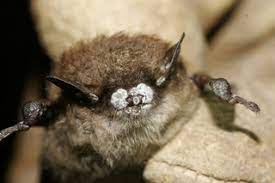The White-Nose Syndrome Epidemic
By Alessandra Faccone, 2021-2022 Environmental Leader
The little bird-like animals you sometimes see flying around at night during the summer are on the path to being endangered in North America. Right now, bats are threatened by a disease called White-Nose syndrome, which has wiped out 90-100% of populations in some of the colonies around the continent (What). If the bat population continues to decrease at this rate, there will be unforeseeable and detrimental effects on pollination and insect populations.

As its name refers to, afflicted bats have white fuzz on their noses; this fuzz is made up of the spores of the fungus that causes it. Pseudogymnoascus destructans is that fungus, and since it grows in cold, dark, and damp places, it spreads throughout bat colonies during their winter hibernation in caves. Bats are already most vulnerable when they are hibernating because of their inactive state, which enables the fungus (What).
The fungus attacks the bare skin of the bats, which is mainly their nose, ears, and wings; it erodes the skin and then replaces it, which causes “catastrophic disruption of wing-dependent physiological functions” (Cryan). This disruption of normal bat functions causes irregular behavior, which is defined as White-Nose Syndrome. The species that have been hit the hardest by WNS include the Northern Long-eared bat, Little Brown bat, and Tricolored bat. So far, it is estimated that more than 1 million bats have died, which makes this the largest in magnitude known epidemic of bats.
After biologists observed sick and dying bats in caves in upstate New York during the winter from 2006-2007, the disease has since been in North America. After its discovery, biologists noticed it had been present in bats in Europe and Asia, but these bats were not as sickly as the ones infected with it in North America. Below is the spread of White-Nose Syndrome throughout North America.
 Compiled by the WNS organization.
Compiled by the WNS organization.
The fungus impairs normal physiological functions because of the way it infects the wings of the bats. Characteristics of the wing membrane like suppleness, elasticity, and tone are compromised, so when the bat wings are folded during hibernation, they adhere to each other and tear easily. Exposed wing membranes lead to evaporation water loss, which can be dire for the bats since they are predisposed to dehydration during hibernation. Healthy wing membranes are critical for maintaining water balance in bats, and when that is compromised, the WNS-affected bats develop behaviors and habits to compensate for the fungal infection and water loss. They tend to select roosts that are more humid and hibernate in tight clusters. Paradoxically, these behavioral adaptations may put the bats at greater risk of fungal infection and subsequently dehydration that results from fungal damage to wings. More frequent torpors also occur so bats can restore their water balance. Bats also tend to lick condensation from fur. These behaviors make up the disease, and the disease results in emaciation and mortality. It is hypothesized that wing damage from the disease could “sufficiently disrupt water balance to trigger frequent thirst-associated arousals with excessive winter flight, and subsequent premature depletion of fat stores resulting in the emaciation associated with WNS” (Cryan).
How can we help to stop the spread of this disease? Staying out of caves or mines where bats are suspected to hibernate is the main way to help, but it is also important to learn about bats and teach others about them. Setting up bat houses in your yard and reducing disturbance to natural bat habitats around your home are other ways to conserve WNS-threatened bat populations. This can include reducing outdoor lighting, minimizing tree clearing, and protecting local streams.
Sources:
“What is White-nose Syndrome?” White-nose Syndrome Response Team, U.S. Fish and Wildlife Service, 2022, https://www.whitenosesyndrome.org/about-white-nose-syndrome.
Cryan, P.M., Meteyer, C.U., Boyles, J.G. et al. Wing pathology of white-nose syndrome in bats suggests life-threatening disruption of physiology. BMC Biol 8, 135 (2010). https://doi.org/10.1186/1741-7007-8-135.
About the Author:
 Alessandra Faccone, 2021-2022 Environmental Leader
Alessandra Faccone, 2021-2022 Environmental Leader
For her Spring Conservation Project, Alessandra designed a bat conservation project that involved building bat houses to sustain the threatened bat population in Bethesda and researching the Eastern Red bat through interviews with species conservation experts. Learn more about the bat conservation project here.





